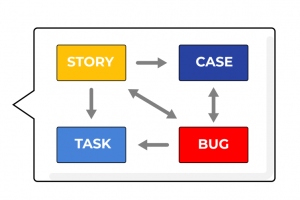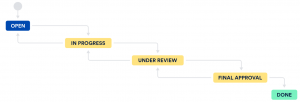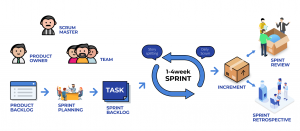- 1. A Brief Overview of ZenTao
-
2. Best Practices Comparison: ZenTao VS Jira
- 2.1 Best practices of Project in ZenTao vs Jira
- 2.2 Best practices of Workflow in ZenTao vs Jira
- 2.3 Best practices of Stories in ZenTao vs Jira
- 2.4 Best practices of Roadmap in ZenTao vs Jira
- 2.5 Best practices of Users and Roles in ZenTao vs Jira
- 2.6 Best practices of Reports in ZenTao vs Jira
- 2.7 Best practices of Dashboards in ZenTao vs Jira
- 2.8 Best practices of Search in ZenTao vs Jira
- 2.9 Best Practices of Agile in ZenTao
- 2.10 Best Practices of Waterfall in ZenTao
- 2.11 Best Practices of Automation in ZenTao vs Jira
- 2.12 Best Practices of Requirements & Test case management in ZenTao vs Jira
- 3. Use cases Comparison: ZenTao VS Jira
- 4. Get started with ZenTao
- 5. Import Jira Data to ZenTao Tutorial
- 6. Reference: Glossary of items in ZenTao VS Jira
Glossary of items in ZenTao & Jira
- 2022-12-14 15:46:01
- Yujia Li
- 684
- Last edited by Yujia Li on 2022-12-14 15:47:58
- Share links
1. Issue vs. Story, Task, Case and Bug
A Jira 'issue' refers to a single work item of any type or size that is tracked from creation to completion. For example, an issue could be a feature being developed by a software team, a to-do item for a marketing team, or a contract that needs to be written by a legal team.
In ZenTao, the concept of the User Story is adopted to describe the requirements from the customer. In Jira, every task, bug, enhancement request; basically, anything to be created and tracked via JIRA is considered an Issue.
In Jira, an Issue can be
• Sub-Task − This is the sub-task of an issue. In a logged issue, there can be different tasks to resolve it, which are called as sub-tasks.
• Bug − A problem that impairs or prevents the functions of the product.
• Epic − A big user story that needs to be broken down. Created by JIRA Software - do not edit or delete.
• Improvement − An improvement or enhancement to an existing feature or task.
• New Feature − A new feature of the product, which is yet to be developed.
• Story − A user story. Created by JIRA Software - do not edit or delete.
• Task − A task that needs to be done to achieve team’s goal.
In ZenTao
The concepts of product, project, and test are clearly defined
Product team, dev team and QA team coordinate with each other
The three teams work on stories, tasks, and bugs to deliver the product
2. Project
It is much simpler in ZenTao. In Product module, users create stories; in project module, users report and resolve bugs; in QA module, users perform test tasks.
A project is, quite simply, a collection of issues that are held in common by purpose or context. Issues grouped into projects can be configured in a variety of ways, ranging from visibility restrictions to available workflows.
Jira Software projects are flexible working spaces that allow you to group like issues by team, business unit, product, or stream of work. Projects don't need to be tied to the same delivery date. For example, if you group your issues by team, you could have a marketing project, a development project, and a legal project, all of which would track ongoing work of those particular teams.
In ZenTao
Project is a temporary endeavor undertaken to create a unique product or service. Development project management is the application of knowledge, skills, tools, and techniques to project activities to meet the project requirements.
The project in ZenTao is the carrier of a series of tasks generated in order to complete the requirements of customers. According to the type of work, it can be divided into agile projects, waterfall projects, and Kanban projects.
3. Board vs. Dashboard
A board in Jira software is a part of a project that displays issues giving teams a flexible way to view, manage, and reporting on work in progress. Simply put, a board is a visual representation of a team’s workflow within a project.
In ZenTao The dashboard is a visual representation of all the features,which is the plaza leading to all functions. It supports customization, and different blocks can set different display contents. Human input, time consumption, risk size, project progress, etc.
4. Workflow vs. Custom Workflow
Workflows represent the sequential path an issue takes from creation to completion. A basic workflow might look something like this:
Teams can create workflows to drive the progression of issues on a scrum or Kanban board. ZenTao's workflow also supports the customization.
5. Agile
Agile is not a Jira Software-specific term. It's a work philosophy that originated in the software development field and has since expanded to a variety of other industries.
Agile is an iterative approach to project management and software development that helps teams deliver value to their customers faster and with fewer headaches.
Jira and ZenTao Software has major feature sets designed particularly for agile, including scrum or kanban.
6. Backlog
A backlog contains outstanding issues for a team to work on. Zen Tao uses product backlog and sprint backlog in scrum.
7. User Stories & Epics
An epic represents a large body of work, which may require several sprints to complete. Multiple user stories comprise an epic.
A story is one simple narrative; a series of related and interdependent stories make up an epic. The same is true for your work management, where the completion of related stories leads to the completion of an epic. The stories tell the arc of the work completed while the epic shares a high-level view of the unifying objective.
In an agile team, stories are something the team can commit to finishing within a one or two-week sprint. Developers would work on dozens of stories a month. Epics, in contrast, are few in number and take longer to complete. Teams often have two or three epics they work to complete each quarter.
If your company was launching rockets into space and wanted to improve the streaming service for your launches, you might structure your stories like the ones below.
Examples of an agile story:
- iPhone users need access to a vertical view of the live feed when using the mobile app.
- Desktop users need a “view fullscreen” button in the lower right-hand corner of the video player.
- Android users need to be linked to Apple store.
The above stories are all related, and could all be considered individual tasks that drive toward the completion of a larger body of work (an epic). In this case, the epic might be “Improve Streaming Service for Q1 Launch.” Organizing work into stories and epics also helps you and your team communicate effectively within the organization. If you were reporting your team’s progress to the Head of Engineering, you’d be speaking in epics. If you were talking to a colleague on your development team, you’d speak at the story level.
8. Roadmaps vs. Program
Roadmaps create a visual representation of all the epics a team is working on, so teams can plan large pieces of work in advance.
Links for cross-departmental and team projects. ZenTao uses programs to manage. A program is a collection of interrelated and coordinated projects. It is at the highest level and belongs to the concept of a strategic level.
9. Advanced search VS Global search
Advanced search uses Jira Query Language (JQL) to search for specific criteria in issues that can’t be done in quick or basic searches.
Zen Tao's home page has a global search function. It can support multiple sets of conditions to search according to keywords. (Including conditions such as name, status, description, person in charge, creation date, etc.) There are separate search boxes on the Programs, Products, Requirements, Implementation, Bugs, Use Cases, Feedback, Academy, and User pages. The search results cover each keyword.
10. Permissions
Utilize permissions to grant team members different levels of access and to lock down sensitive information.
Products
- ZDOO
- ZDOO Cloud
Support
- Book a Demo
- Tech Forum
- GitHub
- SourceForge
About Us
- Company
- Privacy Policy
- Term of Use
- Blogs
- Partners
Contact Us
- Leave a Message
- Email Us: support@zentaoalm.com









